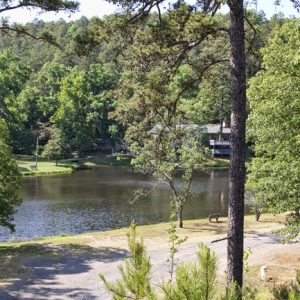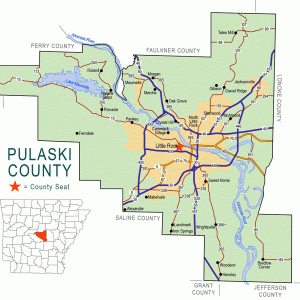calsfoundation@cals.org
Ferndale (Pulaski County)
Ferndale is an unincorporated community in Pulaski County located near the intersection of Kanis and Congo roads west of Little Rock (Pulaski County). Chiefly a farming area, the settlement was once home to a large timber operation and speculative mining.
The first white settlers to the area were the Thomas Reese Sevier family, who briefly settled there in 1838. The first long-term settler was Isaac Crowson, who settled his family there in 1840. The Crowson family was important to the development of Ferndale. In 1875, Dr. George Sutton, also the area’s first physician, was the first to build a home on the actual town site.
As people were gradually attracted to the rich farm land near the Little Maumelle Creek, a post office was established on August 27, 1914, with Walter B. Eaker as postmaster. The name Ferndale was chosen due to the large number of ferns growing near the area’s streams. Many people were drawn to Fletcher Spring due to its reported medicinal properties. In the early 1860s, Lonzo Crowson built a grist mill on Little Maumelle Creek. By 1872, the Mary Williams Masonic Lodge was established, and the Eastern Star followed in 1905. On June 10, 1926, a town plat was filed showing two streets, a church, and a community building. That same year, Dr. W. A. Lamb, Bob Bandy, and Winfield Crowson established a phone line connecting the area to Little Rock.
Area children attended a number of rural schools, including White Oak School and Fletcher Springs School. In 1926, area schools were consolidated into what today are known as the Joe T. Robinson schools of the Pulaski County Special School District. Churches were established as early as the 1850s. Pleasant Grove Baptist Church was founded on May 22, 1852. Spring Valley and Walnut Grove Methodist churches were established in the 1860s. A popular summer camp called Prothro Campground was used by all denominations during the summer. Meetings there ended about 1930. Another religious camp, Ferncliff Camp, was founded by the Presbyterians in 1937.
Beginning in the 1920s, a number of Little Rock’s elite, including Fred Heiskell, editor of the Arkansas Gazette, built camps or retreats in the area. Heiskell built Whisperwood in 1925. Soon, Ferncliff Springs, Okatoma, and Joseph Pfeifer Kiwanis Camp were established.
The most important business interest in the area was timber. Before 1898, Mit Sutton was operating a combination steam sawmill and grist mill. The largest timber concern, which opened in 1907, was operated by the A. J. Neimeyer Company. The sawmill itself was located in Little Rock. Timber was harvested in Ferndale and transported to the mill by way of the Little Rock, Maumelle and Western Railroad. The first work camp, called Maumelle Junction, consisted of dozens of shacks and tents, all of which could easily be moved once the timber was cut out. A commissary was operated by Fred and Horace Wooten. Some African Americans were employed in the enterprise. By 1916, the timber was depleted, and the operation was moved to Saline County.
Speculative mining began as early as 1850 with a mine dug by Thomas Fletcher. Local stories reported that lead was discovered in the area before the Civil War. If that is true, the discovery was never exploited. Other mining operations opened in the area in the early 1900s. None proved profitable. In 1907, the Big Bear Mining Company opened a copper mine southeast of Ferndale. It shut down after about four years. In 1933, Joe Fairchild opened a small gold mining operation west of the community that was ultimately unsuccessful.
The town suffered a tragedy in 1926 when three daughters of the family of Mr. and Mrs. W. C. Crowson drowned when the family’s wagon was overturned in the swollen Fletcher Creek; they had been on the way to school. The sisters were buried together in a special casket on December 22, 1926, in Walnut Grove Cemetery.
In 2010, Ferndale consisted of several stores and businesses, one restaurant, a Cooperative Extension Service 4-H center, two churches, a community meeting center, Ferncliff Camp, and residential housing.
For additional information:
Henker, Fred. “Ferndale Western Pulaski County.” Pulaski County Historical Society Review 21 (March 1973): 1–18.
———. “Little Rock, Maumelle and Western Railroad.” Pulaski County Historical Society Review 13 (June 1965): 17–19.
Matlock, David. “A History of the Wooten Villa in Ferndale, Arkansas.” Pulaski County Historical Review 72 (Summer 2024): 44–49.
“Professor Traces History of Ferndale for LR Society.” Arkansas Gazette. November 10, 1972, p. 3A.
Mike Polston
CALS Encyclopedia of Arkansas
 Ferncliff Camp
Ferncliff Camp  Ferndale
Ferndale  Pulaski County Map
Pulaski County Map 



I visited the Walnut Grove Cemetery off Kanis yesterday. I noticed a grave marker engraved: CROWSON, Mary S. Oct 21, 1911; Mollie F. Apr 7, 1916; Myra M. Sept 29, 1918; Drowned Dec 21, 1926; On back side of the marker was: Erected by parents, teachers, schoolmates and friends [Editor’s note: We added information about the drowning of the three Crowson sisters to the entry.]
A bit more info. for you on the Ferndale area. Before it was actually called Ferndale, ca. 1890, the Ferndale area was called Doe Branch and the original post office was built by Noah Richards. It also served as a residence for the Richards family and two generations of the Miles family until 1992. It is currently owned by a descendant of the Miles family.